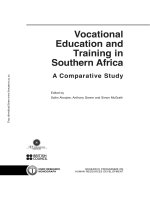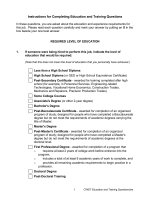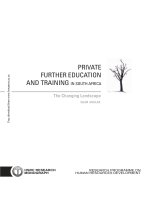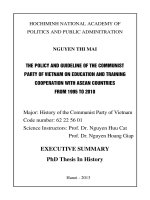Ministry of Education and Training of THAI NGUYEN doc
Bạn đang xem bản rút gọn của tài liệu. Xem và tải ngay bản đầy đủ của tài liệu tại đây (829.29 KB, 78 trang )
VTTN
vttn Workshop
Ministry of Education
and Training
THAI NGUYEN AUGUST 2008
DAY ONE DAY TWO DAY THREE DAY FOUR
8.00 – 9.30
1.Opening
ceremony
Warmer
Introductions
Course outline
-What is speaking?
5. Controlled to
free(r) speaking
activities
9. Speaking activities to
use in the Language
Focus lesson.
13. Peer Teaching
BC trainer /all
trainers
9.30 – 9.50
9.50 – 11.00
2.
Problems in teachin
g speaking and sugg
ested solutions.
6. Motivation 10. Pronunciation
BC trainer
14. Peer Teaching
BC trainer/all
trainers
11.00 – 13.30
13.30 – 15.00
3
. Classroom Experi
ences DVD
- observation task an
d reflection
7. Demonstrations
of speaking
activities
11. Focus on Tieng Anh
-analyse speaking
lessons
-adapting and exploiting
lessons to take into
account student
ability/interest/need
15. Review
Workshop
evaluation
Certificates
Closing ceremony
for final VTTN
workshop
15.00-15.20
15.20 – 16.30
4.
What makes a good
speaking lesson?
Group guideline buil
ding.
8. Evaluating,
correcting and
giving feedback to
students on their
speaking skills
12. Lesson Planning
What is speaking?
What inputs/skills/knowledge do students
need in order to speak in English?
inputs
skills
knowledge
Suitable topic
Knowledge: knowledge of grammar systems,
knowledge of appropriate language to use, knowledge
of suitable exchange patterns to use, knowledge of
phonology, knowledge of topic, awareness of what
your speaking partner knows and is interested in…
Inputs: interesting topic, ideas and questions to
respond to, teacher’s and students’ enthusiasm,
personal experiences, listenings, readings, short video
clips, memories etc
Suggestion:
Skills: ability to pronounce clearly, ability to organise
and develop ideas in real time, being able to produce
chunks (phrases), being able to ask for clarification,
being able to check understanding
What is our aim in speaking?
What is our aim in speaking?
A. To say sentences without making
A. To say sentences without making
mistakes?
mistakes?
B. To communicate with others in English?
B. To communicate with others in English?
What is speaking?
What is speaking?
1.
1.
What level of quality of speaking should we
What level of quality of speaking should we
expect from our students? Why?
expect from our students? Why?
2.
2.
How is speaking different to writing? Why?
How is speaking different to writing? Why?
3.
3.
What roles does the teacher have in a
What roles does the teacher have in a
speaking lesson? Why?
speaking lesson? Why?
Problems in
teaching speaking
and
suggested solutions
VTTN
THAI NGUYEN AUGUST 2008
Characteristics of speaking that cause
Characteristics of speaking that cause
our students to have problems
our students to have problems
•
the need to operate in real time
the need to operate in real time
•
the unpredictability of most speaking
the unpredictability of most speaking
events
events
•
how information or meaning is conveyed
how information or meaning is conveyed
•
( structure, phonology)
( structure, phonology)
•
the ability to listen effectively
the ability to listen effectively
Problems: (See handout)
Possible solutions:
1.Too much time pressure can negatively affect a speaking
activity. You need to make sure that the time you set for a
speaking activity is realistic and allows students thinking
and planning time. Ensure the tasks are clear, focused and
meaningful for the students.
2. Don’t ask students to do a speaking activity that you
know won’t interest them – even if it is in the textbook!
Try to personalise speaking as much as possible. This
makes it real and motivates students to want to
communicate.
Problems: (See handout)
Possible solutions:
3. How you group the students needs careful consideration.
Don’t be afraid to move students around. Think about
allocating roles in an activity which will give all students a role
and therefore a reason to speak
4. During speaking classes, ensure that students have
the opportunity to develop conversation skills/strategies
as well as simply practice speaking. Set up an activity
carefully so that students know the language and
strategies to complete the task successfully.
Problems: (See handout)
Possible solutions:
5. Encourage students and praise them. Provide correction
for controlled activities, but limited correction during fluency
activities. Praise students for ideas in a dialogue or
discussion, not for accuracy of language
6. Give students plenty of planning time. Make speaking a
part of most of your lessons so that students become more
fluent over time
Problems: (See handout)
Possible solutions:
7. Set up speaking activities carefully. Plan your
instructions and check them. Make sure the task is clear
and meaningful. Always ask yourself why you want the
students to work in groups or pairs. Does the activity need
to be done in group work? If there is no reason for
students to work in groups to achieve a set goal, then they
won’t!
8. This links to solutions 7, 1 and 2
Problems: (See handout)
Possible solutions:
9. Anticipate problems with the activity and pre-
teach/revise anything necessary. Lower level students will
speak more confidently if tasks involve language they are
familiar with. Lower level students also cope better with
more concrete tasks e.g. planning a tour of an interesting
place, rather than a discussion on the advantages and
disadvantages of television, for example.
Speaking
DVD
VTTN
THAI NGUYEN AUGUST 2008
TIME AFTER TIME
ICE CUBE
REPEAT AFTER ME
MISSING YOU
ONE IN MILLION
NO ONE TO BLAME
TRY TO UNDERSTAND
FORGIVE AND FORGET
MADE IN CHINA
WALK IN THE PARK
RED IN THE FACE









